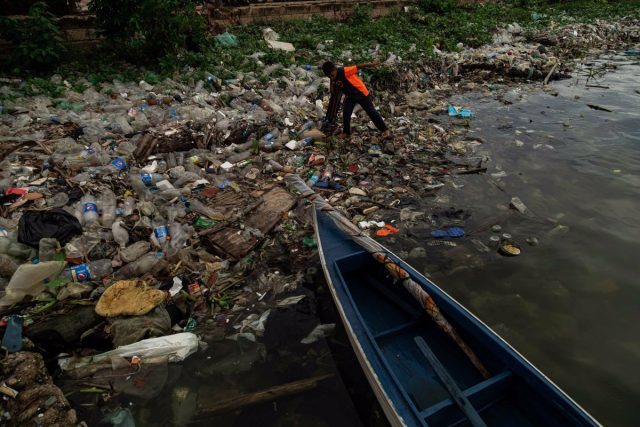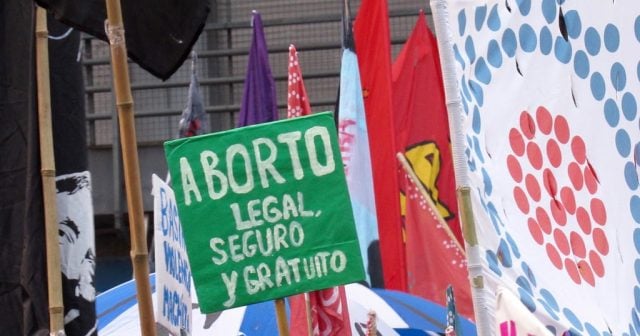A new report warns of what has been a clamor since 2018. That year China decided to close its borders to the entry of plastic waste from other countries and Latin America became the emerging destination: the new plastic ‘dumping ground’ in the world.
For more than six months, a team from the Ojo Público Cross-Border Investigative Network and PopLab has followed thousands of tons of this particular waste that reaches five countries in the region: Mexico, Peru, Ecuador, Chile and Colombia. They come mainly from the US and the European Union. The promise is that these materials will be recycled, but the opaque commercial exchange and the lack of vigilance by the authorities of the countries that receive them, makes it impossible to know the final destination of this waste.
Ojo Público‘s monitoring has been exhaustive, as can be seen on its website, where the route of thousands of shipments of this garbage can be seen over the last 10 years. However, the actual exchange may be much higher, given the low transparency and illegal trade that occurs in this sector.How much plastic garbage arrives in Latin America?
Mexico is one of the countries in Latin America with the highest consumption of plastics and at the same time it has become a ‘landfill’ for the US. In total, from 2012 to 2022 it has received 897,000 tons of plastic waste.
At that time, 62,000 tons of plastic waste arrived in Peru, mostly from the Dominican Republic, Chile and Costa Rica. The main importing companies are dedicated to the manufacture of construction products, industrial tools and the management and recycling of plastic waste.
In these ten years, 50,000 tons arrived in Chile and 45,500 in Colombia. And Ecuador, which is one of the three main countries that receives plastic waste from the US, received 21,000 tons in the last decade.
Among these wastes are containers and other products that can be recycled, although it is estimated that only a small portion reaches that destination, but also medical waste such as syringes, old monitor cases or buckets that, at some point, contained toxic products.
According to the report, this garbage comes mainly from the US, China, Holland and Germany, but also from other countries in the region such as Venezuela, Argentina, Brazil, Panama or Puerto Rico.An opaque business in Latin America
Companies from the US are the ones that send the most plastic garbage to Latin America. According to the Ojo Público study, 111 million tons made this trip in the last two decades, generating a business of more than 500 million dollars.
The purchase and sale of this type of waste is a business that the governments that receive this type of ‘garbage’ are often unable to supervise and do not even have the sufficient capacity to process the high volumes that enter their territory.
Between 2000 and 2019, plastic production almost doubled globally; however, its waste grew at an even higher rate, reaching an increase of 126%.
In addition, the information gap in this matter is evident. The supervision in the customs office that allows the entry of merchandise is deficient, so that sometimes, it is not even known that what is entering the country is waste. Even when this is known, the lack of follow-up procedures by the authorities makes it impossible to be certain about its final destination.
All this problem makes several environmental organizations maintain that the volume of this waste is much greater than that officially indicated.
The International Criminal Police Organization (Interpol) already warned in August 2020 that this lack of supervision increases the illegal trade in plastic waste, as well as its improper treatment. In addition, sometimes it involves illicit work, money laundering, corruption or tax evasion, among other crimes.A worldwide problem
Globally, only 6% of plastic waste is recycled. However, the theory is that the imported material should be used to produce other lower quality material or to make textiles. But it is impossible to calculate how much of this ‘waste’ follows that planned route and how much ends up in legal or improvised dumping sites.
These remains can be highly polluting ‘waste’, becoming a major environmental problem. Even though their destination is recycling, many do not have the right conditions for this process, others contain toxic waste and others entail a high use of water due to the need to wash them.
The recipient countries, as in Latin America, are signatories to the Basel Convention on the Control of Transboundary Movements of Hazardous Waste and their Disposal, a convention signed by all countries except Haiti and the US, one of the main exporters of this type of ‘waste’.
In 2019, this body adopted two decisions that made the Basel Convention the only legally binding global instrument for the specific approach to plastic waste. However, their directives are not followed to a large extent by the countries involved in this particular trade.
Thus, a report by the Autonomous Group for Environmental Research (GAIA) for Latin America, entitled ‘Garbage colonialism does not stop in Latin America’, already warned in 2020 that on many occasions companies do not report the type of product that they are importing before customs, so that countries cannot exercise their right to issue their consent to the entry of these plastic waste.
As the US is not a member of the Basel Convention, it can take advantage of bilateral or multilateral agreements, which affects Mexico. This country must adhere to the free trade agreement with the US and Canada, which establishes that municipal waste and waste, in general, are free of tariffs.Aggravated by the pandemic
This enormous problem became more acute after the coronavirus pandemic exploded worldwide in March 2020. Plastic waste increased strongly as a result of basically two circumstances: the increase in medical supplies, such as the massive use of masks; and the multiplication of food consumption at home, with its corresponding packaging.
The constant use of masks, gloves, medical waste and plastic food packaging caused a collapse in many countries. In the UK, for example, 46% of recycling facilities scaled down or suspended services in April 2020.
After the pandemic, the World Health Organization has also made an urgent call to improve plastic waste management systems. They calculate that around 87,000 tons of personal protective equipment, which had been purchased between March 2020 and November 2021, ended up as waste once used.Difficult solution
The production of recycled plastic has grown considerably in the past two decades. Thus, between 2000 and 2019 the increase has been 327%. But it is still a small market, making up only 6% of the raw material for new plastic products.
However, projections suggest that plastic waste will continue to increase. According to experts, the main reasons are that economies prioritize profit over environmental damage and that governments do not exercise effective control over these markets.
The good news for Latin America is that there are forums that work on this problem. Thus, it is expected that in 2025 the United Nations Organization will present an international regulation that addresses the production of plastics, pointing out issues such as its reduction, types of plastic that can be manufactured or the prohibition of toxic additives.











